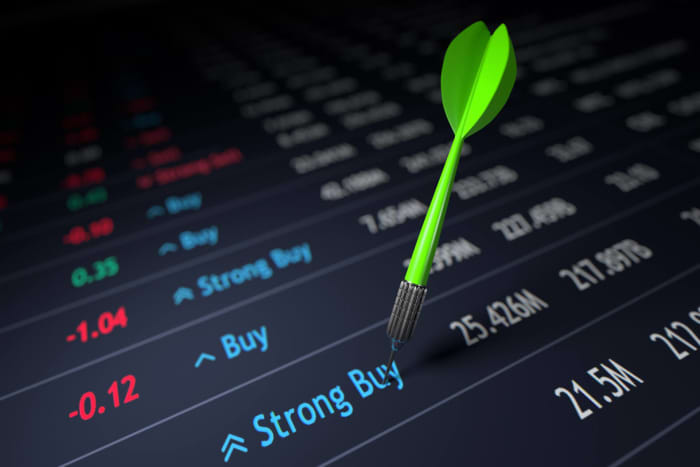One of Your Associates Continues to Make the Same Mistake When Stocking Shelves
Andrew is a self-educated business owner and entrepreneur with plenty of free advice (which is worth exactly what you pay for it!).

One of the best ways to succeed in investing is to avoid the mistakes almost everyone else makes.
There are many minefields out there awaiting the intrepid investor who is adventurous enough to do battle against Wall Street. Retail investors have some advantages over those constrained by institutional rules, and knowing this can provide you with some comfort, but we're still susceptible to some really dumb mistakes that can seem reasonable at the time.
Over the last few years, I've taken note of three of the most destructive things otherwise intelligent investors tend to do, and I'll list them here and offer ways to become aware of them (after all, as after-school television taught me, "knowing is half the battle. Yo Joe!" Here they are, in no particular order.
1. Anchoring
This one hurts since I've probably been more guilty of anchoring than the other two combined, and it's not just me—nearly every investor has a tendency to do this. How many times have you read, "past performance is no guarantee of future results" or something to that effect? Nevertheless, we tend to do all sorts of extrapolations based on past trends and project what has happened into the distant future without taking everything we can into consideration, especially how future developments might be affected by tomorrow's conditions.
One particularly sinister mistake tied to this phenomenon is price anchoring. Ever buy something at a store simply because it was 50% off? You get really excited for the deal, then you race home, only to realize that what you've just purchased isn't worth what you paid for it since you have no interest in owning the thing.
Well, this happens with stock investing all the time, and there are a couple of different ways this can manifest itself into your portfolio. First, the concept of a value trap can really get us value investors. This happens when you see a stock crash, or maybe buy it before it crashes, and then when the price drops dramatically, you automatically buy more.
The problem is that it's possible that market conditions have changed, or something within the company you own has changed (this can be way worse). The solution here is to take a look and consider the current intrinsic value of the company, not the price it's selling for today vs. what you paid for it. "Wall Street doesn't care what you paid for the stock," as Peter Lynch might put it. Instead, consider what the business is worth right now. Take another look before buying more.
Similarly, a stock you own can go up in price. Just because you paid less for it before, does not mean it's not a buy today. The solution here is exactly the same: Take another look at the intrinsic value right now, and try to figure out why the price is rising so much. There might be a really good business case for your stock to be worth a great deal more today, but there also might not. The only way to find out is to take a look.
Anchoring can rear its ugly head in lots of other places and scenarios, including macroeconomic metrics like GDP or employment numbers, or stock market measures, like when you think the S&P will revert to its usual P/E ratios next year, and you bet big on this happening. I'm not going to try to talk you out of placing bets like this, but you should probably ask yourself why it is that you think you have a macro edge when millions of brilliant people are also placing similar bets. Individual companies are tough enough, but trying to time the market or macro picture is almost always folly.

Don't buy and sell based on price changes alone—buy and sell based on value.
2. GIGO: Garbage In, Garbage Out
If you're trying to determine the value of a business, you'll probably need to know a little bit about the DCF (Discounted Cash Flow) method. This means looking at the free cash a company produces and using this knowledge to project how much cash it's going to produce "from now until Judgment Day," as Buffett has opined. From there, you discount the amount back to today's values, taking into account things like inflation and how today's money will be worth less tomorrow.
It's easy to fall into a trap of trying to be ever more precise with your DCF valuations; after all, we are ingrained through much of our education as kids to dial into ever more precise answers to mathematical equations. As a result, whenever we're given a precise number, we tend to put a lot more stock in the accuracy of the results than if the estimate is a range of numbers.
If I say that XYZ stock is worth $345.32 per share, and it's selling at $400 today, then you'll see that it's an undervalued buy, and you may get excited about this opportunity. However, how you come up with those numbers is a really, really important part of determining how accurate these numbers really are.
On the other hand, if I tell you XYZ is probably around 25% undervalued, and I'm about 75% sure of this, and if the stock turns out to be overvalued (or doesn't live up to my expectations), it's still likely to pay a strong dividend (that's well covered by the cash flows even under bad market conditions), then that's a whole lot more useful. Similarly, XYZ might be 25% undervalued, but I'm only about 50% sure of this; further, if I'm wrong, there's a good chance the company will go to zero—that's a really different sort of analysis.
Scroll to Continue
Read More From Toughnickel
The moral of the story here is not to aim for precision in a valuation, but instead to determine a range of possibilities while making sure you can live with the downside.
3. Dangerous Acronyms
Okay, so this third mistake I see a lot of people making is represented by a few different acronyms: FUD, FOMO, and YOLO. However, as we'll see, these are all really manifestations of the same underlying problem: caring what other people are saying.
Fear, Uncertainty, and Doubt (FUD)
FUD stands for fear, uncertainty, and doubt. Typically, FUD is used to describe any time someone is hesitant to dive in and invest since they're listening to "the haters" out there telling them that they'll lose everything if they start managing their oen portfolio, or telling them that they're crazy to invest right now with market conditions being too low, too high, or too Goldilocks for them. Don't listen to this; just do your own research and make up your own mind about your investment timing and decisions.
Fear of Missing Out (FOMO)
FOMO stands for fear of missing out. Like FUD, this one can exert a sort of pressure on your decision-making process, but FOMO tries to disrupt you from the opposite direction. If your friends are all having massive gains from their rocketing stock, you might be tempted to buy what they're buying just so you don't miss out on what they're experiencing.
It may be helpful to remember two snippets. First, you don't have to swing at every pitch (there are no "called strikes" in investing), and second, you should feel happy for your friends who are doing well—not jealous. Recognize this feeling for what it is, and get it out of your life right now. Good for them; you'll do well on your own terms with your own decisions.
You Only Live Once (YOLO)
YOLO stands for you only live once. This one's similar to FOMO, but the implications can be even more extreme. Peer pressure encourages generation after generation of investors to dive in recklessly, and it's almost like you're a chicken if you don't jump in with both feet first.
Falling into the YOLO trap, even when all of your friends are wildly successful, can be a great way to lose all of your money. Instead, use discipline and a boring routine in order to avoid this destructive feeling. Don't follow the herd blindly, and make your own decisions about what's best for you and your portfolio.
Check Out the Big Brain on You
As an investor, your best asset is your mind. It can process an incredible amount of information, but it can also be a tremendous liability if you let the wrong influences in. Guard against what the herd is doing by avoiding FOMO, YOLO, and FUD mindsets and focus on objective reality and what's best for you, and you alone.
Use contrarianism in order to vanquish these decision demons. Remember that accuracy in projecting future earnings and what a stock is worth isn't the goal, but instead, have a realistic range of fair value along with a wide margin of safety in case you're wrong.
Finally, anchoring to a price that made sense at some arbitrary point in the past isn't useful, as Wall Street doesn't care at what price you bought a stock at. Keep these three common mistakes in mind, and the upside is ever more likely to take care of itself.
This article is accurate and true to the best of the author's knowledge. Content is for informational or entertainment purposes only and does not substitute for personal counsel or professional advice in business, financial, legal, or technical matters.
Andrew Smith (author) from Richmond, VA on September 11, 2021:
Thanks, Anish!
Anish Patel from San Francisco + Mumbai on September 11, 2021:
Great Tips!
Source: https://toughnickel.com/personal-finance/3-Stock-Buying-Mistakes-to-Avoid
0 Response to "One of Your Associates Continues to Make the Same Mistake When Stocking Shelves"
Post a Comment